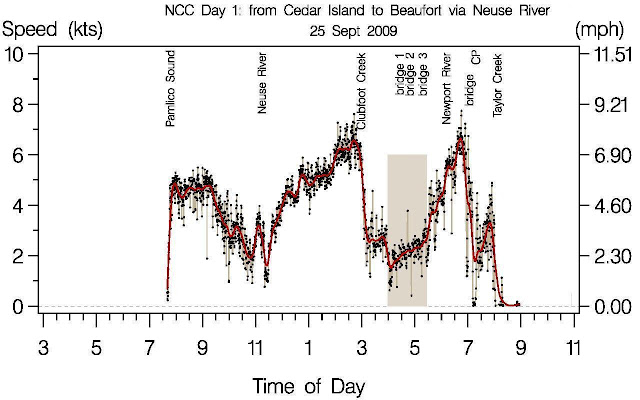It was a rewarding adventure sailing from the beach on Pamlico Sound to Beaufort. Although we covered only the first half of the course on that trip, we became good friends with the Harlowe waterway (under 3 bridges), the Pamlico/Neuse waters rounding Piney Island point (with bombing range), and the Newport River/Taylor Creek approach to Beaufort. We gained ~ 3.5 hours of rowing practice. In the Neuse we inadvertantly capsized the Dawn Patrol for the first time (ever), proved that it was no big deal, and gained the confidence to go back home and routinely practice capsize-and-recovery drills (on purpose).
“It’s a dingy, and capsize and recovery is a normal expectation”. --Alan
Day1 and Day2
I previously posted a report of this scouting trip in the B and B Yachts Forum on the Mess-About website, along with 45 photos and 4 weather charts posted on Picassaweb.
Recently I took a new look at the GPS data for our sailing and rowing from that 2-day scouting trip. Here are those data along with a few highlights...
Day 1
The winds on the Pamlico Sound were initially light as we rounded Piney Island into the Neuse River. We occasionally rowed in the hot sun for a moment or two whenever the sails hung lifeless and the Pamlico turned to glass. By 2pm the afternoon storms had kicked in to send us beating through sizable chop up the Neuse in 16 knot winds with 20-24 knot gusts. I was at the helm when we capsized. Twenty minutes later we were all bailed out, none the worst, and on our way reefed to the max in increasing winds.
The storms cleared away the heat of the day left us in cooler air. By 6:40pm we needed to shake the reefs out. By 8:00 pm the wind had died. In the cool of the evening I rowed for an hour to bring us to a good stopping point and anchorage in the mouth of Clubfoot Creek --gateway to the Harlowe waterway. As we glided along during that hour, the stars were out overhead, silent lightning flashed in the far distances, Alan prepared a hot dinner for us, and for some unknown reason we were treated to a fireworks display in the sky over Morehead City / Beaufort (our destination) on that moonless night.
Key: GPS speed (black dots connected by tan lines), smooth curve (red), rowing (tan rectangle).
Garmin GPSmap 76CSx was set to record [lat, lon] and time at 20-second intervals.
Day 2
At 7:00 am we sailed off our anchor, stopped for 5 minutes at Matthews Point Marina for water, and then short-tacked the first 3 miles into Clubfoot Creek. The next 2.5 hours introduced us to rowing into a 1.5 knot current through the beautiful Harlowe Canal and its three faces: the gentle Neuse River flora and fauna of Clubfoot Creek, skirting the Croatan National Forest via the narrow canal under a canopy of trees and spanned by three low bridges, winding through the lush green and brown marsh grasses of Harlowe Creek to reach the open tidal waters of the Newport River. It was another hot day but we had a wonderful adventure discovering the Harlowe waterway and verifying that we did indeed fit under the three bridges with a few vertical inches to spare. Piece of cake.
Rowing through Harlowe Creek
The ride on the Newport River into Beaufort on 13-17 knot winds was fast. We reefed. Approached the draw bridge and sailed through when it opened with oars at the ready.
Then passing "Check Point #1" (CP) we sailed on down Taylor Creek to the public boat ramp. Dawn was waiting for us (of course!) at a public boat ramp. The 5-10 knot gusty wind blowing toward the ramp, together with low-tide banks of oyster shell and mud to the right and left conspired against us; ultimately, Dawn backed the trailer down the ramp into the water and Alan sailed the Dawn Patrol up unto the trailer.
Key: GPS speed (black dots connected by tan lines), smooth curve (red), rowing (tan rectangle).
Garmin GPSmap 76CSx was set to record [lat, lon] and time at 20-second intervals.
We were out of the water by 5:25pm. Dawn did not believe we capsized. As we told her about our weekend, we finally convinced her that we were not pulling her leg, and she was glad we had that experience under our belts. We had cruised and scouted the first 65 miles of the ~100mile NC Challenge.
A Month Later
A month later in the NCC 2009 race, Alan and I sailed and rowed the same 65 miles in half the time --in large part thanks to cooperative conditions. The other half of the race course (from Beaufort around Harkers Island and up Core Sound back to the start/finish line) was another story.









.jpg)






